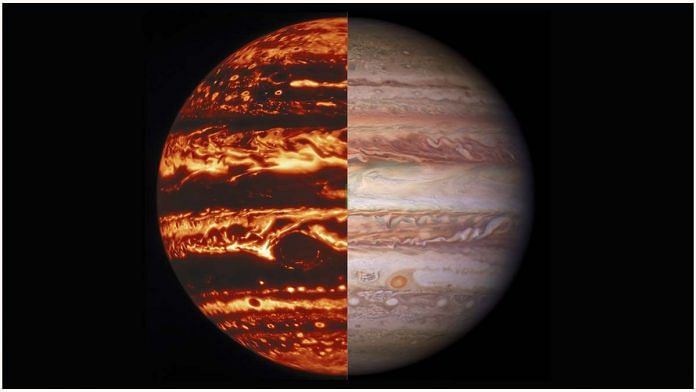
[ad_1]

Text Size:
Bengaluru: Astronomers operating the NASA’s Juno spacecraft have made the first direct measurement of the depth of Jupiter’s Great Red Spot, the famous storm on the planet that is three times as wide as the Earth, and has been swirling for centuries. The findings indicate that the storm extends to a depth of approximately 300 kilometres (imagine 34 Mount Everests placed one on top of each other), with a maximum depth limit of 500 kilometres.
Juno flew over the storm below the altitude of 20,000 kilometres, in February and July 2019, enabling the team to collect data about the storm.
The astronomers used two techniques to calculate the magnitude and depth of the storm. One was the use of gravitational data as Juno flew over the storm, and the other was microwave data.
The findings were published in two papers in the journal Science this week.
Also Read: NASA telescope may have just helped find the first planet spotted outside Milky Way
The red storm
The Great Red Spot is an anticyclonic storm, which means its winds blow in the anti-clockwise direction in the Southern Hemisphere. It has been observed continuously since the 1800s, and is red in colour. Its shade varies, going from bright red to pale pink to white and sometimes disappearing, but the exact mechanism of the colour variations, driven by solar ultraviolet radiation and its reaction with gases, is not fully understood.
Jupiter’s atmosphere is made up of several bands of winds running parallel to the equator and flowing across the planet in both directions. The lightly coloured bands are called zones and the dark ones are called belts. The Great Red Spot is located at the edge of the South Equatorial Belt.
The colour of the storm also contrasts against the winds of this dynamic belt. If the belt is lighter in colour, the storm becomes darker, and vice versa.
The storm is 16,350 kilometres wide, and is the largest storm or wind phenomenon in the solar system. It is a high-pressure region with colder temperatures and high winds.
Gravitational anomaly
The increased density of the storm, compared to the surrounding layers of atmosphere, creates a localised increased gravity effect. In fact, the planet itself is not gravitationally symmetrical across both hemispheres, and this is explained by the extremely powerful winds driving the Great Red Spot.
This gravitational anomaly causes any spacecraft flying over the storm to experience a mildly higher tug, which can then be used to calculate the mass of the storm — and thus its other properties. The authors of the gravity paper describe the storm as being 300 km deep, with a 100 km margin both ways.
They calculated a maximum depth constraint of 500 km.
The microwave radiometer instrument onboard Juno is a group of radiometers that record Jupiter’s electromagnetic flux up to a depth of 600 kilometres. Its readings help understand the temperature at different altitudes and through layers of winds, as well as the composition of the clouds. It also allows the researchers to create heat maps of different layers of the atmosphere and find wind features belonging to the storm.
This storm is also shallower than the zonal jets, which extend to depths of up to 3,000 km. The scientists are not sure why the storm does not extend to this depth. There isn’t enough data yet to understand why the storm subsides at a maximum depth of 500km.
(Edited by Neha Mahajan)
Also Read: NASA gives ‘front-row view’ of Perseverance dangling, then landing & audio from Mars
Subscribe to our channels on YouTube & Telegram
Why news media is in crisis & How you can fix it
India needs free, fair, non-hyphenated and questioning journalism even more as it faces multiple crises.
But the news media is in a crisis of its own. There have been brutal layoffs and pay-cuts. The best of journalism is shrinking, yielding to crude prime-time spectacle.
ThePrint has the finest young reporters, columnists and editors working for it. Sustaining journalism of this quality needs smart and thinking people like you to pay for it. Whether you live in India or overseas, you can do it here.
[ad_2]
Source link